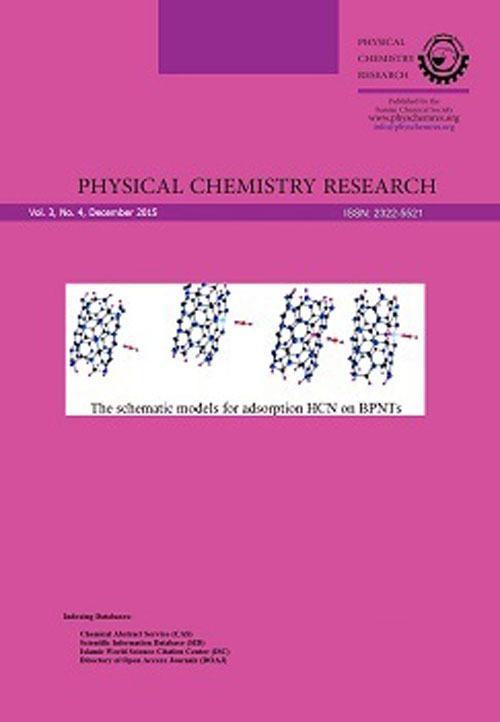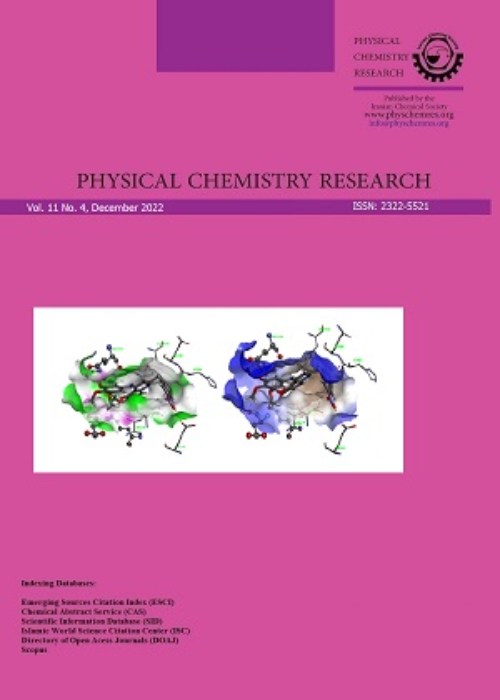فهرست مطالب

Physical Chemistry Research
Volume:3 Issue: 4, Autumn 2015
- تاریخ انتشار: 1394/06/18
- تعداد عناوین: 9
-
-
Pages 265-277
In this research, the interactions of HCN gas with pristine, Ga-, N- and GaN-doped of boron phosphide nanotube (BPNTs) were investigated by using density function theory (DFT). The structure, electrical and NQR parameters, quantum descriptors involving energy gap, global hardness, global softness, electrophilicity, electronic chemical potential and electronegativity were calculated. The adsorption energy values of the AI-BIV models were negative and the adsorption process was exothermic. GaN-doped impurity atoms increased the adsorption of HCN gas on the surface of nanotube and the GaN-doped model was favorable than other models. The NQR parameters of the fourth layer of pristine and N-doped models were more than those of other models due to the change of the geometrical parameters. The energy gap between LUMO and HOMO orbital changed slightly from 2.83-3.09 eV, with adsorption of HCN gas on the surface of BPNTs. The global hardness and ionization potential and natural charge of NBO calculations showed a charge transfer from the HCN molecule (nucleophile agent) to the nanotube models (electrophile agent).
Keywords: BPNTs, DFT, HCN interaction, Ga, N, GaN-doped -
Pages 279-291
Prediction of available vapor pressure data in the case of compounds containing C-H-O led to derivations and recommendations of standard equations for this property. The accuracy of vapor pressure estimations is essential to use as a basis to calculate acentric factor, thermal and equilibrium properties. In this study, according to the previous work, an accurate equation to estimate vapor pressure is developed to 130 pure C-H-O compounds as a function of reduced temperature and critical pressure. With new proposed equation, vapor pressures have been calculated in comparison with experimental data reported in literature for 2019 data points of 130 pure C-H-O compounds and the overall average absolute relative deviation is only 0.333%. The accuracy of the developed equation has been compared to that of Antoine and other mostly used equations. Our comparisons show that new equation leads to more accurate results than those of literature methods.
Keywords: Vapor pressure, C, H, O, Pure compounds, Correlation, Antoine -
Pages 293-298
In this research, TiO2 nanoparticles were synthesized by a simple wet chemical method. TiCl4 was used as precursor in hydrogen peroxideand ethanol. The TiO2 nanoparticles were characterized by transmission electron microscopy (TEM), scanning electron microscopy (SEM), X-ray diffraction (XRD), electron dispersive spectroscopy (EDS) and UV-Vis spectrophotometer. The particle size of the as-synthesized TiO2 was estimated by XRD and TEM analyses in the range of 5-10 nm. The SEM images showed that the size of sphere-like shaped nanoparticles decrease with increasing annealing temperature. The prepared TiO2 nanoparticles were characterized for phase composition, using X-ray diffractometry. The crystal structure of the nanoparticles after annealing was measured by XRD analysis. It was realized that phase transition from anatase to rutile occurs after heat treatment at 600 °C. The particle size of the annealed sample was also calculated about 20 nm by XRD analysis. The EDS spectrum showed peaks of titanium and oxygen with fewer impurities. The UV-Vis spectrum showed anatase and rutile phase at wavelength about 375 nm (Eg = 3.30 eV) and 470 nm (Eg = 2.63 eV) for as-prepared TiO2 and annealed TiO2 nanoparticles respectively.
Keywords: TiO2 nanocrystals, Wet chemical, Anatase, Phase transition, Rutile -
Pages 299-304
Graphene sheet including single vacancy, double vacancy and Stone-Wales with armchair and zigzag structure was simulated using molecular dynamics simulation. The effect of defects on shears modulus, shear strength and fracture strain was investigated. Results showed that these shear properties reduce when the degrees of all kinds of defects increase. The dangling bond in SV and DV defected graphene leads to decrease its mechanical properties especially shear strength and fracture strain where the role of weak interatomic bonds are important. The vacancies in DV defected graphene are also next to each other and slide over each other under shear deformation results to less shear strength than that of SV defected graphene. Results can be useful in tuning the mechanical properties of graphene-based materials that is a key-role parameter in designing and fabrication of nanomechanical systems. However, the maximum and minimum reduction occurs for single vacancy and Stone-Wales defects, respectively. It was also found that distinction between shear properties of zigzag and armchair structures is preserved in defected graphene.
Keywords: Graphene, Simulation, Shear's modulus, Defect -
Pages 305-318
In this work, the results concerning to the mean activity coefficient measurements for NaCl in the (glycerol water) system using the potentiometric method are reported. The potentiometric measurements were performed on the galvanic cells without liquid junction of the type: Ag|AgCl|NaCl (m), glycerol (wt%), H2O (1 - wt)%|Na-ISE, in various mixed solvent systems containing 0, 5, 10, 20 and 30 mass fraction percents of glycerol over ionic strength ranging from 0.0020-3 mol kg-1 at T = 298.2 K. The sodium ion selective electrode and Ag-AgCl electrode as self-made electrodes had a reasonably Nernst response. The modified zeolite was used to fabricate the sodium ion selective electrode as electrochemical sensor. The modeling of the investigated system was made based on an extended Debye-Hückel equation, the Pitzer and Pitzer-Simonson-Clegg models. The unknown parameters were determined for each model. The resulting values of the mean activity coefficients, osmotic coefficients and excess Gibbs energy are reported for the studied system.
Keywords: activity coefficient, Potentiometry, NaCl, Glycerol, Pitzer model -
Pages 319-330
Most of the biological phenomena are influenced by intermolecular recognition and interaction. Thus, understanding the thermodynamics of biomacromolecule ligand interaction is a very interesting area in biochemistry and biotechnology. One of the most powerful techniques to obtain precise information about the energetics of (bio) molecules binding to other biological macromolecules is isothermal titration calorimetry (ITC). In a typical ITC experiment, a macromolecule solution is titrated by a solution containing a reactant at a constant temperature, and exchanged heat of the reaction is measured, allowing determination of thermodynamic parameters (enthalpy change, entropy change, change in Gibbs free energy, binding affinity and stoichiometry) of molecular interactions. In this review article, we describe the ITC approach briefly and review some applications of ITC for studying protein-ligand interactions, protein-protein interactions, self-association, and drug design processes. Furthermore, the application of ITC for determination of kinetic parameters of enzyme catalyzed reactions as well as thermodynamic parameters will be discussed.
Keywords: Isothermal titration calorimetry, Ligand binding, Enthalpy of binding, Drug design, Enzyme kinetics -
Pages 331-339
In this work, Ag-Cu nanoparticles (with different percentages of copper, 10%, 25%, 50%, 75% Cu) were synthesized by wet chemical method. Copper(II) sulfate and silver nitrate were taken as metal precursors, ascorbic acid as reducing agent and anhydride maleic (MA) as a modifier. The prepared nanoparticles were characterized by means of X-ray diffraction (XRD) technique and scanning electron microscopy (SEM-EDAX), Fourier transform infrared spectroscopy (FT-IR) and UV-Vis spectroscopy. SEM indicated the formation of uniform spherical crystalline nanoparticle in a well distributed size and morphology. It can be seen from these pictures that the particle size decreased with increasing of the copper percent. When the molar ratio of Cu2ﰈ is 75/25 (>50%), mixture of the spherical and hexagonal nanoparticles was prepared. Three pronounced Ag diffraction peaks (111), (200) and (220) appeared at 2θ = 38°, 43.9° and 64.1°, respectively. The three most intense peaks of the XRD pattern of sample showed a slight shifting of the center of the diffraction peaks toward a lower angle. No shifting was observed in XRD lines with the increase of Cu2 to Ag ratio in the Cu2ﰈ mixed solution (> 50% Cu). Fourier transform infrared spectroscopy (FT-IR) showed that nanoparticles are coordination between oxygen atoms and nanoparticles, because functional unit C=O present in MA, shifts to 1652.69 cm-1 after embedding nanoparticles. The position of the surface plasmon resonance (SPR) absorption band on the nanoparticles could be shifted from 380-350 nm via the change of their percentage of Cu.
Keywords: Different percentages of copper, Control size, Copper, silver, Wet, chemical method, Optical properties -
Pages 341-346
Due to some important applications of guanine electrode in scientific and technology research such as electro-chemical DNA based biosensors, and a problem of high redox potential of guanine (0.81 V), our research study concentrates on reducing guanine redox potential by substituting Cu, Ag, Au, CH3, C2H5 and Cl on sites of 1, 2 and 9 of guanine. A 5.0% reduction of redox potential for 9-Ag-guanine was the sign of favorable result. In order to have further lower potential, sliver clusters (Ag2 andAg3) were used. The obtained percentages of reduction of potentials were 53.6% and 36.8% for 9-Ag2 and 9-Ag3-guanine, respectively. In this research, Gaussian 09 was used and DFT was applied with long-range corrected xc-functional (LC-BLYP).
Keywords: Redox Potentials, Guanine, Substitutions, Biosensor -
Pages 347-360
The compressibility factor of nonassociated chain molecules composed of hard convex core Yukawa segments was derived with SAFT-VR and an extension of the Barker-Henderson perturbation theory for convex bodies. The temperature-dependent chain and dispersion compressibility factors were derived using the Yukawa potential. The effects of temperature, packing fraction, and segment number on the compressibility factor were investigated for chains of the prolate sphereocylinder segments. A comparison of hard core Yukawa chain compressibility factor values and hard chain compressibility factor values showed that the type of interaction potential has more effect on those chain molecules with higher segment numbers. The results demonstrated that in reduced temperatures 1.4 and 2.4, the Yukawa chain of the compressibility factor is insensitive to temperature, while the dispersion term of the compressibility factor changes remarkably with the temperature. The derived equation of state can fairly predict the SAFT-VR results of the hard sphere core chain molecules in the limit of α = 1.
Keywords: Convex body, Chain molecule, Perturbation theory, SAFT-VR, Yukawa potential


